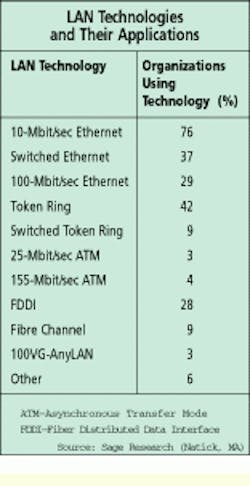The past is prologue for Gigabit Ethernet
The past is prologue for Gigabit Ethernet
Michael Fahey
If the current buzz about Gigabit Ethernet sounds familiar, it should. The emerging ieee 802.3 standard specification is merely the latest in a long line of local area network (LAN) protocols touted as the next big thing in high-speed networking. Like its predecessors, Gigabit Ethernet is being hailed as a potential spur for fiber deployment. What is the reality behind all of the hype? On the theory that a look at the past is helpful in attempting to divine the future, an examination of other high-speed alternatives to Ethernet may be instructive in evaluating Gigabit Ethernet`s potential in the marketplace.
From the perspective of fiber deployment, Fiber Distributed Data Interface (FDDI) provides an instructive case study. The technology emerged in the late 1980s and early 1990s with the promise of providing an order of magnitude more bandwidth than Ethernet. Yet while the 100-megabit-per-second protocol has proven to be a useful niche technology, it has never sold in anywhere near the quantities envisioned by its advocates--which, at one time, included nearly all of the networking vendors.
FDDI`s problems began with the high price of the necessary optoelectronic devices and the general scarcity of fiber in desktop environments. Advocates even attempted to push a copper version of the technology to circumvent these obstacles. But with the advent of switched Ethernet--which gave bandwidth- hungry users easier access to all of Ethernet`s existing 10 Mbits--a potent alternative had arrived. As a new wrinkle on an existing technology, switched Ethernet was well-understood by users and did not involve the major network upgrades required by FDDI.
To make matters worse, Ethernet further evolved to Fast Ethernet, which "stole all of FDDI`s underlying technology," according to Bob Grow, vice president of industry relations at XLNT Inc., a San Diego, CA-based producer of network technology and an original equipment manufacturer for major vendors. "The existing FDDI physical-layer specifications for fiber and for copper were taken to do Fast Ethernet," he says.
Grow, whose company was an FDDI pioneer and is now a member of the Gigabit Ethernet camp, thinks Gigabit Ethernet can succeed by taking the same tack as Fast Ethernet. According to Grow, just as Fast Ethernet borrowed from FDDI and Ethernet, Gigabit Ethernet has borrowed from Fibre Channel, including its transceiver designs. Thus, he sees the success of Fast Ethernet as a harbinger of good things for Gigabit Ethernet. For example, it is now possible to buy a Fast Ethernet Network Interface Card for $63, he says--a very attractive price for a network technology that is only several years old.
Moving out
The use of Fibre Channel`s underpinnings is one reason that Gigabit Ethernet has moved so quickly from the drawing board to actual product. This was highlighted at Networld + Interop in Las Vegas, where 7 of the approximately 20 Gigabit Ethernet LAN vendors in attendance demonstrated their products working together. Grow says that while the demonstration was not a rigorous interoperability test, it did show that various Gigabit Ethernet suppliers could exchange data among their products. Grow says that in addition to the economies associated with building on existing technology, Gigabit Ethernet`s evolutionary approach will hold appeal for users and application developers already familiar with the Ethernet model of networking.
Still, there remain many standards and design issues to be ironed out in Gigabit Ethernet, including the specification for copper transmission. However, since Gigabit Ethernet is viewed primarily as a backbone technology, the wisdom of using it over copper has been questioned in many quarters. "Users would be doing themselves a disservice if they implement Gigabit Ethernet on copper," says Tom Nolle, president of CIMI, a Voorhees, NJ-based network consulting company.
This is where fiber may come into play. Nolle says that while many organizations presently have limited fiber to vertical runs between floors, users are increasingly moving fiber into the horizontal links that connect servers to servers and servers to the network. Nolle says that such fiber-rich networks combined with switching and high-speed protocols like Gigabit Ethernet are an important strategy for network managers confronted with a constant increase in applications.
Challenge from atm
However, Nolle emphasizes that Gigabit Ethernet is a nascent technology and therefore must be viewed skeptically. Such a view becomes particularly warranted in light of the fact that another alternative--Asynchronous Transfer Mode (ATM)--is waiting in the wings.
While Gigabit Ethernet and atm will invariably compete to some extent, the latter is "more mature and more ambitious," says Cecil Christie, atm product manager for Cisco Systems. atm, he says, provides quality-of-service capability that enables users to tailor bandwidth to best meet the needs of different kinds of traffic. However, Christie says that Gigabit Ethernet has the potential to provide users with "fatter pipes" that will significantly increase LAN capacity. Unlike atm transmission, Gigabit Ethernet will provide these pipes without dramatically changing network architectures.
Despite his skepticism, Nolle says that Gigabit Ethernet could derail atm for economic reasons. "If atm sells at up to 15% more than the price of traditional LAN technology, the flexibility of atm will make converts and there will be a significant amount of atm deployed," he says. Conversely, according to Nolle, if Gigabit Ethernet can be priced significantly lower than atm, it could put a real damper on atm`s acceptance in the market.
Granted, it is early in the game, but that sounds a lot like the fate that befell FDDI.
Michael Fahey, a former staff writer for Lightwave magazine, is a freeLANce writer based in Arlington, MA. This article was adapted from Lightwave, another PennWell publication.

